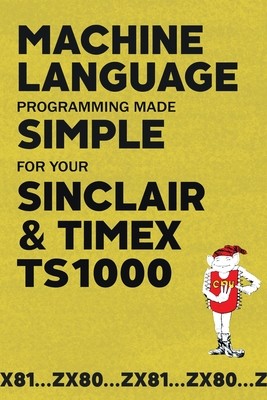
- We will send in 10–14 business days.
- Publisher: Acorn Books
- ISBN-10: 1789829666
- ISBN-13: 9781789829662
- Format: 15.2 x 22.9 x 0.9 cm, minkšti viršeliai
- Language: English
- SAVE -10% with code: EXTRA
Machine Language Programming Made Simple for your Sinclair & Timex TS1000 (e-book) (used book) | bookbook.eu
Reviews
Description
Launched in 1981, Sir Clive Sinclair's ZX81 - successor to his ZX80 released the year before - was designed to be a low-cost introduction to home computing for the general public. It was a hugely successful machine, with over one and a half million 'official' units being sold; many more unauthorised 'clones' were also produced, particularly in Russia and other Eastern Bloc countries of the era. One could either purchase the machine pre-built, or - as a significant number of consumers did - buy it in kit form for assembly at home at a slightly cheaper price. This 'DIY' approach, encouraged by Sinclair Research, became a core element of the computer's genetic make-up. Those who were comfortable putting together the four silicon chips and other such components were just as keen to poke around the machine's memory, learning as much as they could about its capability; the programs they would write could easily be shared once saved onto a standard audio cassette.
This is one of the earliest published books addressing the subject of programming the first generation of home computers. First released in 1981 by Melbourne House it helped owners of the ZX80, ZX81 (and later the Timex TS1000) learn how to make the most of their machine, commanding the CPU directly rather than through a BASIC interpreter - an abstraction level that slowed things down considerably.This book was an entry point into advanced computer use; many who would go on to have long careers in the technology world owe their start to the tutorials and explanations featured within. As such it is an important part of computer history and remains useful for anyone interested in retro programming, particularly on the early Sinclair machines.* * *Acorn Books is proud to present its Retro Reproduction Series, a collection of classic computing works from the 1980s and 90s, lovingly reproduced in the 21st century. From standards of programming reference no self-respecting microcomputer user would want to be without, to obscure works not found in print anywhere else, these modern reprints are perfect for any connoisseur of retro computing.- Publisher: Acorn Books
- ISBN-10: 1789829666
- ISBN-13: 9781789829662
- Format: 15.2 x 22.9 x 0.9 cm, minkšti viršeliai
- Language: English English
Launched in 1981, Sir Clive Sinclair's ZX81 - successor to his ZX80 released the year before - was designed to be a low-cost introduction to home computing for the general public. It was a hugely successful machine, with over one and a half million 'official' units being sold; many more unauthorised 'clones' were also produced, particularly in Russia and other Eastern Bloc countries of the era. One could either purchase the machine pre-built, or - as a significant number of consumers did - buy it in kit form for assembly at home at a slightly cheaper price. This 'DIY' approach, encouraged by Sinclair Research, became a core element of the computer's genetic make-up. Those who were comfortable putting together the four silicon chips and other such components were just as keen to poke around the machine's memory, learning as much as they could about its capability; the programs they would write could easily be shared once saved onto a standard audio cassette.
This is one of the earliest published books addressing the subject of programming the first generation of home computers. First released in 1981 by Melbourne House it helped owners of the ZX80, ZX81 (and later the Timex TS1000) learn how to make the most of their machine, commanding the CPU directly rather than through a BASIC interpreter - an abstraction level that slowed things down considerably.This book was an entry point into advanced computer use; many who would go on to have long careers in the technology world owe their start to the tutorials and explanations featured within. As such it is an important part of computer history and remains useful for anyone interested in retro programming, particularly on the early Sinclair machines.* * *Acorn Books is proud to present its Retro Reproduction Series, a collection of classic computing works from the 1980s and 90s, lovingly reproduced in the 21st century. From standards of programming reference no self-respecting microcomputer user would want to be without, to obscure works not found in print anywhere else, these modern reprints are perfect for any connoisseur of retro computing.

Reviews